IJCRR - 7(14), July, 2015
Pages: 07-20
Print Article
Download XML Download PDF
A Study of attitude towards sex education of college going students in relation to their home environment
Author: Parveen Kumar, Archana Mittal
Category: Healthcare
Abstract:Students are the future of a nation. The progress of any nation depends on the physical and mental well-being of the students. Positive attitude towards sex education may prevent the students from many diseases. Objectives: 1) To study and compare the attitude towards sex education of college going students, 2) To compare the attitude of college going students towards sex education in relation to their home environment. Methods: Normative survey method has been used in this study. 300 college going students were selected as sample through stratified random sampling technique from the rural and urban area of district Haridwar. Attitude Scale towards Sex Education developed by Dr, (Smt.) Usha Mishra and Home Environment Inventory developed by Dr. K.S. Misra were used to collect the data. The collected data was analyzed using Mean, S.D. and 't' test. Results and Conclusions: College going students have high attitude towards sex education. Urban female students have shown very high positive attitude towards sex education. Area has affected the attitude of college going students towards sex education as the urban students have been found to have more favorable attitude towards sex education. Sex had not affected the attitude of rural students towards sex education. Home environment and its dimensions have affected the attitude of students towards sex education. The study recommended provisions to formulate effective policies in favor of sex education in schools. It
provides complete and healthy information for necessary life skills to deal with the problems of future life.
Keywords: Attitude, Sex education, Students, Home environment
Full Text:
INTRODUCTION
It is remarked that the destiny of any country shapes in its class rooms. But it is possible only, if the students studying in the class rooms are physically and mentally strong. Education should be imparted for both physical and mental well-being. In the present scenario, the Indian students are adapting western life style which is a blend of healthy and unhealthy entertainment and pleasure. They have easy access to modern technologies by which they are not only getting valuable knowledge but also they are under the dark influence of incomplete knowledge of intimate relationships. Due to this, they are inviting lots of physical, mental as well as sexual diseases like HIV/AIDS and STDs. These diseases are increasing day by day due to the lack of proper knowledge, awareness and modes of prevention. To protect our children, society, nation and humanity at large from this horrible situation, there is a dying need of sex education in India. Sex is a taboo in India and sex education is a big taboo to be talked about. Children are not allowed to have access to sexual health information because the society has the perception that such exposure will corrupt the child[1]. But Frimpong (2010) views that sex education is a systematic attempt to promote the healthy awareness in the individual on the matters of his or her sexual development, functioning, behavior and attitude through direct teaching [2].In the view of SIECUS (2004), “Sex education is a lifelong process of building a strong foundation for sexual health through acquiring information and forming attitudes, beliefs and values about identity, relationship and intimacy”[3]. Sex education focuses on all the aspects of life. The need and importance of sex education has been documented by many researchers. Toor, K.K. (2012) observed that in the absence of effective sex education, the immature adolescents make major decisions without ad equate knowledge. Sex education is required for children to provide them positive direction, right information which would avoid unnecessary worries and tensions [4]. Sex education will provide scientific knowledge and healthy attitude towards the issues related to sexuality. Majova, C.N. (2002) found that secondary school learners were favorably disposed towards Sex education [5]. Mahajan and Sharma (2005) observed that mothers were reluctant to talk about sex education to their daughters [6]. Ogunjimi, L.O. (2006) in his study found that majority of the students and parents were in support of the inclusion of sex education [7]. Sieswerda, L.E. and Blekkcenborst, P. (2006) found that parents believed that they should take lead role in teaching sexual health [8]. Students feel that sex education should be introduced in the senior high school curriculum and it is important for young people [9][10]. Parents and teachers have been found to have favorable attitude towards the importance of school sex education [11][12][13]. It can be concluded from the above discussion that sex education is the need of hour especially in India. Newspapers, Periodicals, journals and magazines often carry queries of the people regarding their sexual life and problems. To get rid of these problems the one and the only answer is that teaching of sex education should be institutionalized in schools and colleges only then their quires and problems will be solved honestly and scientifically. But there is a conflicting situation among parents, teachers and students regarding the inclusion of sex education. Many times people raise their arguments in the favor as well as in the opposition of the sex education. So it becomes mandatory that parents, teachers and students should have positive attitude towards sex education and they should be prepared to accept the sex education as a subject. Attitude of students towards sex education is influenced by their socio-cultural background, belief system, political system, religion and many other factors. But home environment is such a factor which affects the attitude of students towards sex education intensely. Considering all these factors, it was attempted to study the present status of attitude of college going students in relation to their home environment.
Statement of the Problem
“A study of attitude towards sex education of college going students in relation to their home environment”
Operational Definition of the Terms
Attitude towards Sex Education: Sex education is a broad term treated as a usual topic for health education. Attitude towards sex education means the views of the people regarding the introduction of sex education in the school curriculum. In the present study, attitude towards sex education means the scores obtained by the college going students on Attitude Scale towards Sex Education.
College going Students: In the present study college going students mean those students who have passed Intermediate and are studying in undergraduate courses. \
Home Environment: Home environment means the psycho-social climate of the home. In the present study home environment refers to those ten dimensions which are given by Dr. K.S. Misra in his Home Environment Inventory [14], which are as follows:
• Control: It indicates the autocratic atmosphere in which many restrictions are imposed by the parents.
• Protectiveness: It implies prevention of independent behavior and prolongation of infantile care.
• Punishment: It includes physical as well as affective punishment to avoid the undesirable behavior.
• Conformity: It refers to demands to work according to parents’ desires and expectations.
• Social Isolation: It indicates the isolation from beloved persons except family members for negative sanctions.
• Reward: It includes material as well as symbolic rewards to increase the probability of desirable behavior.
• Deprivation of Privileges: It implies controlling children’s behavior by depriving them or their rights to seek love, respect and child care from parents.
• Nurturance: It means existence of excessive unconditional physical and emotional attachment of parents with their child.
• Rejection: It implies that child has no right as a person and has no right to express his feelings.
• Permissiveness: It indicates provisions of opportunities to child to express his views freely and act according to his desires. In this way, the home environment means the sum of the above ten dimensions. In the present study, home environment means the scores obtained by college going students on Home Environment Inventory.
Aim
The broad aim of the study is to know the attitude towards sex education among college going students and to investigate the impact of home environment on their attitude towards sex education.
Objectives of the Study
Following objectives were framed to achieve the purpose of the study:
1. To study the attitude towards sex education of college going students.
2. To compare the attitude of college going students towards sex education. 3. To compare the attitude of college going rural students towards sex education in relation to their home environment.
4. To compare the attitude of college going urban students towards sex education in relation to their home environment
. 5. To compare the attitude of college going male students towards sex education in relation to their home environment.
6. To compare the attitude of college going female students towards sex education in relation to their home environment.
Hypotheses of the Study
Following hypotheses have been formulated in order to achieve the objectives of the study:
1. There is no significant difference in the attitude of college going students towards sex education.
2. There is no significant difference in the attitude of college going rural students towards sex education in relation to their home environment.
3. There is no significant difference in the attitude of college going urban students towards sex education in relation to their home environment.
4. There is no significant difference in the attitude of college going male students towards sex education in relation to their home environment.
5. There is no significant difference in the attitude of college going female students towards sex education in relation to their home environment.
Delimitations of the Study
The present study has been delimited as follows:
1. The study is delimited to the district Haridwar (Uttarakhand).
2. The study has included college going students only.
3. The present study is delimited to the students of science group only. The students of non-science background have not been included in this study.
4. The study included both male and female students.
5. The present study has involved rural as well as urban area of district Haridwar.
MATERIAL AND METHODS
Method Used Selection of the research method depends on the objectives and nature of the research problem. According to the nature of the present problem, the investigators have employed ‘Normative Survey’ method of research which is concerned with the situations and conditions of the present time. The present study deals with the attitude of college going students towards sex education in relation to their home environment along with their sex and area. Hence the present study is based on Normative Survey Method.
Population of the Study All the college going male and female students residing in the rural and urban area of district Haridwar, (Uttarakhand) is taken as the population of the present study. The college going students of science background only were the target population in the present study.
Sample and Sampling Procedure A representative sample of 300 college going students was selected by stratified random sampling technique. For the purpose of the study, all the college going students were divided into two strata: students of science background and students of non-science background. Only the students of science background were employed in the present study. The sample had equal numbers of male and female students from rural and urban area of district Haridwar. The sampling framework is present below:
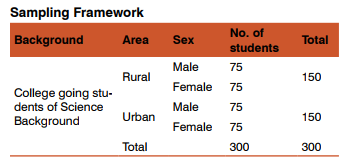
In this way, a sample of 300 college going students was selected randomly.
Variables
The present study involves two kinds of variables, which are stated as under:
• Dependent Variable:In the present study, the dependent variable is attitude of college going students towards sex education which is measured by ‘Attitude Scale towards Sex Education’ [15] developed by Dr. (Smt.) Usha Mishra.
• Independent Variable: Home environment (control, protectiveness, punishment, conformity, social isolation, reward, deprivation of privileges, nurturance, rejection and permissiveness) is the independent variable in the study. It has been measured by Home Environment Inventory[16] developed by Dr. Karuna Shankar Misra.
Statistical Analysis
Mean, S.D. and t-test were used for the statistical analysis.
RESULTS

The above table shows that rural male and female college going students as well as urban male students have shown high attitude towards sex education while urban female students have exhibited very high attitude towards sex education. Rural female students have more favorable attitude towards sex education as compared to rural male students. In the case of urban students, similar results have been obtained as urban female students have higher attitude towards sex education in comparison to urban male students. Urban students have shown more favorable attitude towards sex education than rural students. Mean values show that rural male students have shown least attitude towards sex education. On the other hand, urban female students have exhibited the highest attitude towards sex education.
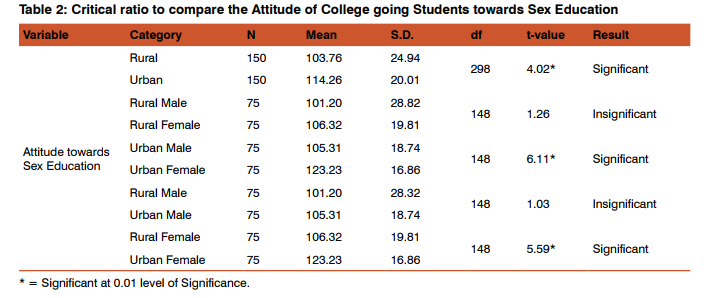
The above table shows the comparison of the attitude of college going students towards sex education. The first, third and fifth‘t’ values for the attitude of college going students towards sex education are 4.02 (df=298), 6.11 (df=148) and 5.59 (df=148) respectively, which are found significant at 0.01 level of significance. It means that there is a highly significant difference between college going rural and urban students, urban male and urban female students as well as rural female and urban female students on their attitude towards sex education. Mean values indicate that college going urban students and urban female students have more favorable attitude towards sex education than college going rural students and urban male students. Means values regarding the female students of rural and urban area indicate that urban female students have higher attitude towards sex education as compared to their rural counterparts. On the other hand, at df=148 the second and fourth ‘t’ values for the attitude towards sex education are 1.26 and 1.03 respectively, which are found insignificant. It means that rural male and rural female students as well as male students of rural and urban area do not differ significantly in their attitude towards sex education.
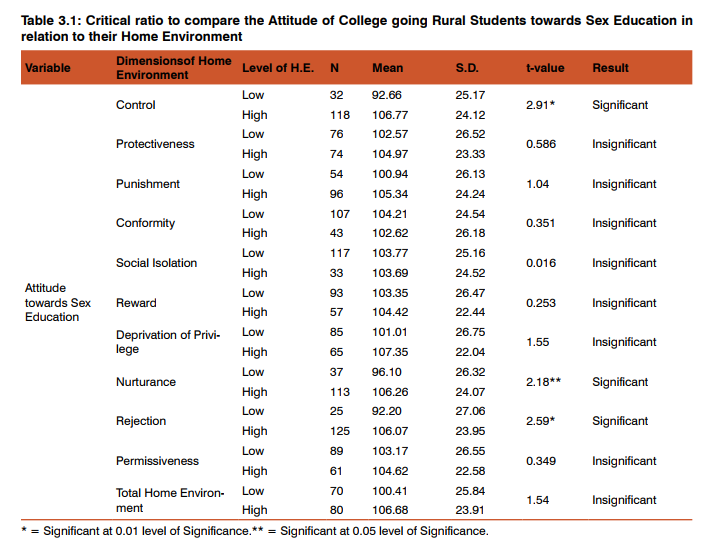
The above table presents the comparison of attitude of college going rural students towards sex education in relation to their home environment. At df 148, the t-values to compare the attitude of college going rural students towards sex education having low and high level of control (t=2.91), rejection (t=2.59) and nurturance (t=2.18) have been found significant at 0.01 and 0.05 level of significance respectively. It indicates that there is a statistical significant difference in the attitude of college going rural students towards sex education having low and high control, rejection and nurturance. Mean values clearly show that rural students who have high control, rejection and nurturance have shown more favorable attitude towards sex education as compared to those students who have low control, rejection and nurturance. On the other hand, the t-values for the comparison of attitude of rural students towards sex education having low and high protectiveness (t=0.586), punishment (t=1.04), conformity (t=0.351), social isolation (t=0.016), reward (t=0.253), deprivation of privileges (t=1.55), permissiveness (t=0.349) as well as total home environment (t=1.54) have been found insignificant. It suggests that rural students having low and high protectiveness, punishment, conformity, social isolation, reward, deprivation of privileges, permissiveness as well as total home environment do not differ significantly in their attitude towards sex education.
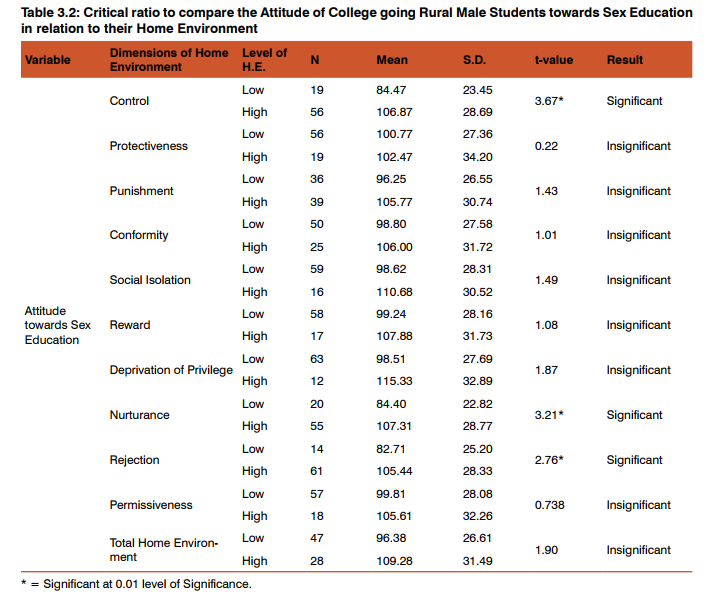
he above table shows the comparison of attitude of college going rural male students towards sex education in relation to their home environment. At df 73, the t-values for the comparison of the attitude of college going rural male students towards sex education having low and high level of control (t=3.67), nurturance (t=3.21) and rejection (t=2.76) have been found significant at 0.01 level of significance. It indicates that there is a highly statistical significant difference in the attitude of college going rural male students towards sex education having low and high control, nurturance and rejection. Mean values indicate that rural male students having high control, nurturance and rejection have shown more positive attitude towards sex education in comparison to those male students who have low control, nurturance and rejection. On the other hand, the t-values to compare the attitude of rural male students towards sex education having low and high protectiveness (t=0.22), punishment (t=1.43), conformity (t=1.01), social isolation (t=1.49), reward (t=1.08), deprivation of privileges (t=1.87), permissiveness (t=0.738) as well as total home environment (t=1.90) have been found insignificant. It reveals that rural male students having low and high protectiveness, punishment, conformity, social isolation, reward, deprivation of privileges, permissiveness as well as total home environment do not differ significantly in their attitude towards sex education.
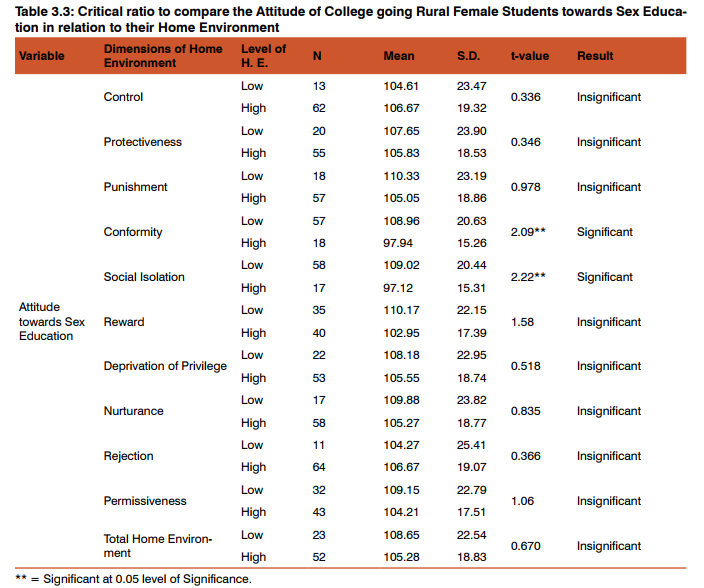
The above table shows the comparison of attitude of college going rural female students towards sex education in relation to their home environment. At df 73, the tvalues for the comparison of the attitude of college going rural female students towards sex education having low and high level of conformity (t=2.09) and social isolation (t=2.22) have been found significant at 0.05 level of significance. It indicates that college going rural female students having low and high conformity and social isolation differ statistically and significantly in their attitude towards sex education. Mean values indicate that rural female students having low conformity and social isolation have shown more positive attitude towards sex education in comparison to those female students who have high conformity and social isolation. But the t-values to compare the attitude of rural female students towards sex education having low and high control (t=0.336), protectiveness (t=0.346), punishment (t=0.978), reward (t=1.58), deprivation of privileges (t=0.518), nurturance (t=0.835), rejection (t=0.366), permissiveness (t=1.06) as well as total home environment (t=0.670) have not been found significant. It reveals that rural female students having low and high control, protectiveness, punishment, reward, deprivation of privileges, nurturance, rejection, permissiveness as well as total home environment do not differ significantly in their attitude towards sex education.

The above table shows the comparison of attitude of college going urban students towards sex education in relation to their home environment. At df 148, the t-values for the comparison of the attitude of college going urban students towards sex education having low and high level of conformity (t=2.68), permissiveness (t=3.11) and social isolation (t=1.96) have been found significant at 0.01 and 0.05 level of significance respectively. It indicates that college going urban students having low and high conformity; permissiveness and social isolation differ statistically and significantly in their attitude towards sex education. Mean values indicate that urban students having low conformity and social isolation and high permissiveness have shown more favorable attitude towards sex education in comparison to those students who have high conformity, social isolation and low permissiveness. But on the other hand the t-values to compare the attitude of urban students towards sex education having low and high control (t=0.302), protectiveness (t=0.324), punishment (t=1.37), reward (t=1.01), deprivation of privileges (t=1.42), nurturance (t=0.083), rejection (t=0.915) as well as total home environment (t=0.083) have not been found significant. It exhibits that urban students having low and high control, protectiveness, punishment, reward, deprivation of privileges, nurturance, rejection as well as total home environment do not differ significantly in their attitude towards sex education.
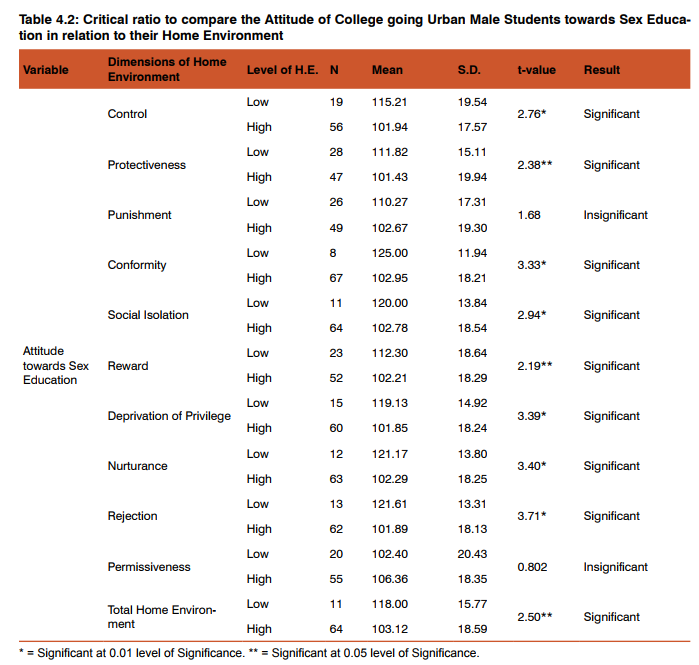
The above table shows the comparison of attitude of college going urban male students towards sex education in relation to their home environment. At df 73, the t-values for the comparison of the attitude of college going urban male students towards sex education having low and high level of control (t=2.76), conformity (t=3.33), social isolation (t=2.94), deprivation of privileges (t=3.39), nurturance (t=3.40), rejection (t=3.71) have been found significant at 0.01 level of significance. But, the t-values for the comparison of the attitude of urban male students towards sex education having low and high level of protectiveness (t=2.38), reward (t=2.19) and total home environment (t=2.50) have been found significant at 0.05 level of significance. It indicates that college going urban male students having low and high control, protectiveness, conformity, social isolation, reward, deprivation of privileges; nurturance, rejection and total home environment differ statistically and significantly in their attitude towards sex education. Mean values indicate that urban male students having low control, protectiveness, conformity, social isolation, reward, deprivation of privileges; nurturance, rejection and total home environment have shown more favorable attitude towards sex education. On the other hand, the t-values to compare the attitude of urban male students towards sex education having low and high punishment (t=1.68) and permissiveness (t=0.802) have been found insignificant. It means that urban male students having low and high punishment and permissiveness do not differ significantly in their attitude towards sex education.

The above table shows the comparison of attitude of college going urban female students towards sex education in relation to their home environment. At df 73, the tvalues for the comparison of the attitude of college going urban female students towards sex education having low and high level of control (t=3.23), punishment (t=4.68), reward (t=3.62), nurturance (t=4.61), permissiveness (t=4.70) and total home environment (t=3.23) have been found significant at 0.01 level of significance. But, the t-value for the comparison of the attitude of urban female students towards sex education having low and high level of rejection (t=2.14) has been found significant at 0.05 level of significance. It indicates that there is a significant difference in the attitude of college going urban female students towards sex education having low and high control, punishment, reward, nurturance, permissiveness, rejection and total home environment. Mean values indicate that urban female students having high control, reward, nurturance, rejection and total home environment have shown more favorable attitude towards sex education. On the other hand, the t-value to compare the attitude of urban female students towards sex education having low and high protectiveness (t=1.13), conformity (t=0.297), social isolation (t=0.858) and deprivation of privilege (t=1.35) have been found insignificant. It means that urban female students having low and high protectiveness, conformity, social isolation and deprivation of privilege do not differ significantly in their attitude towards sex education.
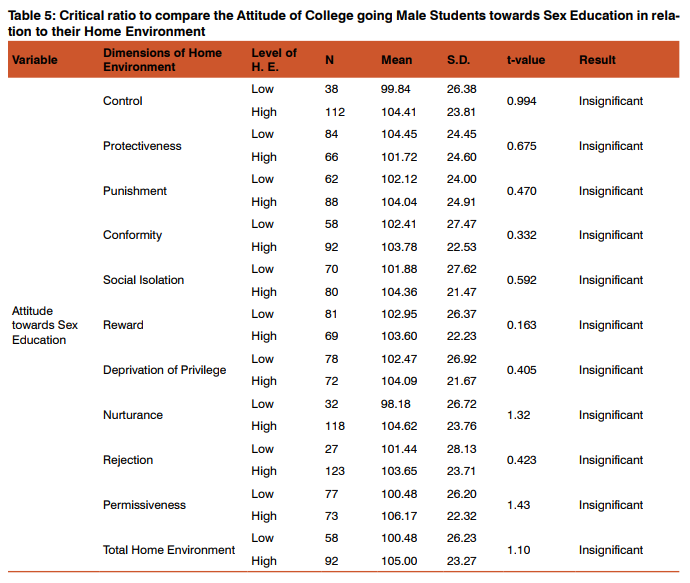
The above table shows the comparison of attitude of college going male students towards sex education in relation to their home environment. At df 148, the t-values for the comparison of the attitude of college going male students towards sex education having low and high level of control (t=0.994), protectiveness (t=0.675), punishment (t=0.470), conformity (t=0.332), social isolation (t=0.592), reward (t=0.163), deprivation of privileges (t=0.405), nurturance (t=1.32), rejection (t=0.423), permissiveness (t=1.43) and total home environment (t=1.10) have been found insignificant. It indicates that there is an insignificant difference in the attitude of college going male students towards sex education having low and high control, protectiveness, punishment, conformity, social isolation, reward, deprivation of privileges, nurturance, rejection, permissiveness and total home environment.

The above table shows the comparison of attitude of college going female students towards sex education in relation to their home environment. At df 148, the t-values for the comparison of the attitude of college going female students towards sex education having low and high level of control (t=1.98) and permissiveness (t=2.40) have been found significant at 0.05 level of significance. It reveals a significant difference in the attitude of college going female students towards sex education having low and high control and permissiveness. Mean values indicate that female students having high control and permissiveness have shown more positive attitude towards sex education. On the other hand, the t-values for the comparison of the attitude of female students towards sex education having low and high level of protectiveness (t=0.425), punishment (t=1.32), conformity (t=1.39), social isolation (t=1.73), reward (t=1.99), deprivation of privileges (t=0.771), nurturance (t=1.74), rejection (t=1.57) and total home environment (t=1.84) have been found insignificant. It indicates that there is no significant difference in the attitude of female students towards sex education having low and high protectiveness, punishment, conformity, social isolation, reward, deprivation of privileges, nurturance, rejection and total home environment.
Discussion
Inclusion of sex education has always been issue of controversy and same has been found in the present study. Rural and urban students have shown different views about sex education. Rural students’ attitude towards sex education has been found comparatively low. Some of the rural students are of the view that sex education invites sexual crime and it has nothing to do with family planning. They also think that there is no need of sex education because it will reduce the interest of the students in the studies. Rural students assert that imparting sex education is against the Indian culture. On the other hand, urban students, specifically female students, have shown positive attitude towards sex education. It was felt that urban students are open minded and have scientific attitude that’s why they have shown more favorable attitude towards the inclusion of sex education. They think that giving sex education means giving scientific knowledge to the students from the prevention of the fatal diseases. Urban students feel that sex education may help them to solve the sex related problems. Female students assert that sex education can save them from sexual assault and can be helpful to eradicate the social evils and crime. They feel that it may be helpful to make good citizens and is appropriate for the needs of the present times.
Conclusions
On the basis of the interpretation of the data, following conclusions are presented as below:
1. College going students except urban female students have been found to have high attitude towards sex education. Urban female students have shown very high positive attitude towards sex education.
2. Area has affected the attitude of college going students towards sex education as the urban students have been found to have more favorable attitude towards sex education.
3. Sex had not affected the attitude of rural students towards sex education but it has put a significant influence on the attitude of urban students towards sex education. Urban female students have exhibited more positive attitude towards sex education.
4. Control has affected the attitude of rural students, rural male students, urban male and female students as well as total female students towards sex education. Highly controlled rural students, rural male students, urban male and female students as well as total female students have shown more positive attitude towards sex education.
5. Protectiveness has affected the attitude of urban male students towards sex education. Urban male students who are less protected have been found to have more favorable attitude towards sex education.
6. Urban female students who fall in the category of high punishment have been found to have more positive attitude towards sex education. But it has not been found to affect the attitude of other students towards sex education.
7. Conformity has affected the attitude of rural female students, urban students and urban male students towards sex education. These students having low conformity have more favorable attitude towards sex education.
8. Social isolation has affected the attitude of rural female students, urban students and urban male students towards sex education. Less isolated rural female students, urban students and urban male students have exhibited more favorable attitude towards sex education.
9. Reward has affected the attitude of urban male and female students towards sex education. Male students who are less rewarded and female students who are highly rewarded have shown more positive attitude towards sex education.
10. Deprivation of privilege has affected the attitude of urban male students towards sex education. Urban male students who are less deprived have shown more favorable attitude towards sex edu-cation.
11. Nurturance has affected the attitude of rural students, rural and urban male students and urban female students towards sex education. Highly nurtured rural students, rural male students and urban female students but less nurtured urban male students have exhibited more favorable attitude towards sex education.
12. Rejection has affected the attitude of rural students, rural and urban male students and urban female students towards sex education. Rural students, rural male students and urban female students having high level of rejection have shown more favorable attitude towards sex education but urban male students having low rejection have shown more positive attitude towards sex education.
13. Permissiveness has affected the attitude of urban students and urban female students as well as total female students towards sex education. Urban students, urban female students as well as total female students who have high permissiveness have exhibited more favorable attitude towards sex education.
14. Home environment has affected the attitude of urban male and female students towards sex education. Urban male students having low home environment have shown more positive attitude towards sex education while urban female students having high home environment have shown more favorable attitude towards sex education.
IMPLICATIONS OF THE PRESENT STUDY
The present study may guide teachers, educators, administrators, planners, policy makers, counselors, parents and students in formulating effective policies in favor of sex education in schools. This study is of enormous importance for the adolescents as it will aid them to have access to complete and healthy information that will guarantee them a reputable future and necessary life skills to deal with the problems of future life. This study may be beneficial for the teachers as well as parents as it would debunk the myths and misconceptions regarding the sex education in schools. The findings of this study may attract those policy makers who are interested to save the future generation and they may be able to determine their role also. It may also be useful for guidance workers and counselors in many ways to solve the problems of students.
Acknowledgement
The authors are firstly thankful to Smt. Murti Devi and Smt. Sunita Mittal (Active Reformer and social worker) for their motivation. We are also thankful to the college principals and students for their cooperation in data collection.
References:
1. Jimmy, E.; Abeshi, S.E.; Osonwa, K.O.; Uwaneda, C.C. and Offlong, D.A. Perception of students’, teachers’ and parents’ towards sexuality education in colabar south local government area of Cross River State, Nigeria. Journal of Sociological Research 2013; 4(2):225-40.
2. Frimpong, S. O. Adolescents’ attitudes towards sex education: a study of senior high schools in Kumasi metropolis. lfe Psychologia 2010; 18(1)https://www.questia.com/trial
3. Sexuality Information and Education Council of the US. Guidelines for comprehensive sexuality education: kindergarten-12th grade. 2004; Third Edition, Retrieved on March 22 from http/www.siecus.org
4. Toor, K. K. A study of the attitudes of teachers, parents and adolescents towards sex education. MIER Journal of Educational Studies Trends and Practices 2012; 2 (2): 177-89.
5. Majova, C.N. Secondary school learners’ attitudes towards sex education. Dissertation, Master of Education (Educational Psychology), University of Zululand, South Africa 2002.
6. Mahajan, P. and Sharma, N. Awareness level of adolescentgirls regarding HIV/AIDS: acomparative study of rural and urban areas of Jammu. J. Hum. Ecol. 2005; 17(4): 313-14.
7. Ogunjimi, L.O. Attitudes of students and parents towards the teaching of sex education in secondary schools in Cross Rivers state. Educational Research and Reviews 2006; 9: 347-49.
8. Sieswerda, L.E. and Blekkenhorst, P. Parental attitudes towards sex education in home: results of a 2003 parent survey conducted in Thunder Bay, Ontario. Thunder Bay District Health Unit, Thunder Bay, Ontario 2006.
9. Frimpong, S. O. Adolescents’attitudes towards sex education: a study of senior high schools in Kumasi metropolis. lfe Psychologia 2010; 18(1):https://www.questia.com/trial
10. Koronya, C. (2007). Determining the knowledge and attitudes of peer youth educators towards sexuality education in Kenya. Sexuality Leadership Development, Post Fellowship, Mini Project, 2007; 2: 1-28
11. Fentahun, N.; Assefa, T.; Alemseged, F. and Ambaw, F. Parents’ perception, students’ and teachers’ attitude towards school sex education. Ethiopian Journal of Health Sciences 2012; 22(2): 99-106
12. Toor, K. K. A study of the attitudes of teachers, parents and adolescents towards sex education. MIER Journal of Educational Studies Trends and Practices 2012; 2 (2): 177-89.
13. Nyarko, K.; Adentwi, K.I.; Asumeng, M.; Ahulu, L.D. Parental Attitudes towards Sex Education at the Lower Primary in Ghana. International Journal of Elementary Education 2014; 3(2): 21-9
14. Misra, K.S. Manual for Home Environment Inventory. National Psychological Corporation, Agra 2012.
15. Mishra, U. Manual for Attitude Scale towards Sex Education. National Psychological Corporation, Agra 2008.
16. Misra, K.S. Manual for Home Environment Inventory. National Psychological Corporation, Agra 2012.
|






 This work is licensed under a Creative Commons Attribution-NonCommercial 4.0 International License
This work is licensed under a Creative Commons Attribution-NonCommercial 4.0 International License